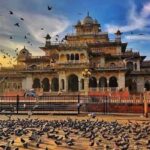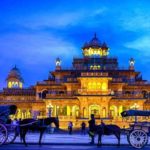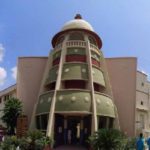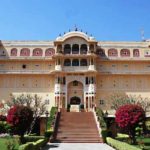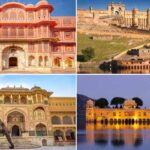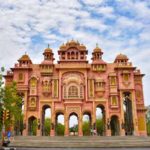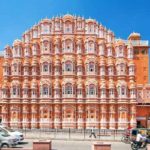Jawahar Kala Kendra (JKK) was established in the repute of vast spectrum of Rajasthani Art and Heritage. JAWAHAR KALA KENDRA is an international institution of art and culture promoting various genres of Indian art and culture. JAWAHAR KALA KENDRA is known as the home of embellishing visual art and culture in Jaipur, Rajasthan. JAWAHAR KALA KENDRA, every year, gets charmed by the exhibitions of different kinds, which includes seminars, workshops, dance and music recitals, theatre shows and publication of books on art and culture. Jawahar Kala Kendra is known for its unique structure which was designed by a popular Indian architect of international honor- Charles Correa. The architecture of JAWAHAR KALA KENDRA resembles to the planned grid of jaipur city.
The Main JAWAHAR KALA KENDRA building consist of administrative block, enthographics museum, exhibition galleries, open theatre, air conditioned theatre, arena, library, dormitories and Indian coffee house. The design of Jawahar Kala Kendra is based on the concept of Indian astrology. The theme ok JAWAHAR KALA KENDRA consist of nine planets with unique features to the institution with each section describing the characters of the respective planets.
The library is situated in the Jupiter section which symbolizes the knowledge and wisdom. The coffee house is in lunar section portraying the aspects of astronomy through the detailed paintings on the wall. The central dome is considered as one important attraction to the tourists and artists, by the charts and paintings on the ceiling describing the Murals from Jain mythology. One honor of Jawahar Kala Kendra is the art gallery The Alankar Museum which represents the art and heritage of Rajasthan through various artifacts which are pride and repute of Rajasthan.
JAWAHAR KALA KENDRA has always been the centre of displaying the international art work in the rajasthan region which owes a respect in the field of art and excellence. The library and audio-visual division is a platform of endowed documentation section which contains a variety of publications of not only theatre and fine arts, but Music has also been the part of the same which is most attracted by scholars and art performers.
As we know that rajasthan is an ambience of rural region as well, the Shilpgram of JAWAHAR KALA KENDRA tokens the rural areas of Rajasthan. Shilpgram is a rural complex adjoining the main building of JAWAHAR KALA KENDRA consists of six huts which are considered as the residence in rural areas. They are names as: Marwar, Braj, Shekhawati, Tribal, Desert land and Hadoti. Every year, JAWAHAR KALA KENDRA surmounts with the biggest festival known as LOKRANG. This festival attributes the traditional culture and ethics of India which comprises of national handicraft fair and national dance festival.
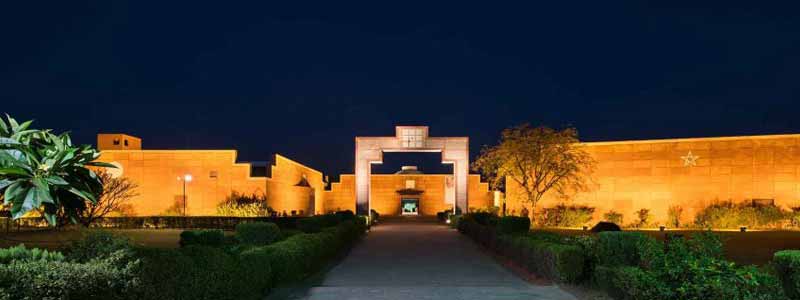
History of Jawahar Kala Kendra Jaipur
The Jawahar Kala Kendra was designed and built by the late architect from MIT, Charles Correa in 1986. The construction of the building was completed in 1991 and is built according to the concept of ‘Navagraha’ (nine planets or nine squares) or commonly called the nine-house mandala.
The construction of the centre was commissioned by the Rajasthan Government and was opened to the art and cultural enthusiasts in 1993 Jaipur Attractions.
As time progressed, the upkeep of JKK went for a toss and the complex started being ignored. The only time when people would gather here would be during functions arranged by government officials or a traditional fair or mela. Around 2015, the then Chief Minister of Rajasthan advised that the Jawahar Kala Kendra be once again refurbished for art and cultural events and exhibitions in an initiative to promote tourism and culture.
The renovations saw modern additions to the Kala Kendra with air conditioners and humidifiers installed in the galleries of museum and library with ramps for wheelchair users.
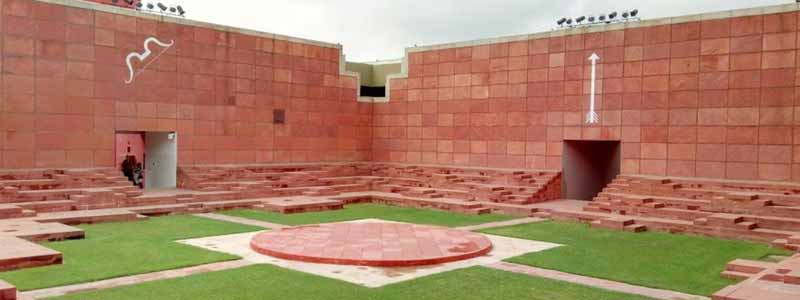
Architecture and Layout of Jawahar Kala Kendra Jaipur
Built with the intention of preserving the ancient culture, traditional and art of Rajasthan, the architectural concept of the Jawahar Kala Kendra is based on the principles of Vastu and Shilpa Shastra. The main building includes theatres, exhibition galleries, dormitories, restaurants, auditoriums and coffee house. Every separate section of the Jawahar Kala Kendra is based on a planet from the Navagraha and resembles the respective planet in color, character, astrological values and functionality.
The entire complex is built in red sandstone and white marble with vastu symbols on the façade of each square structure Jaipur Tour Packages.
As an illustration, the Library building is linked to the planet Jupiter and the attributes of the building resemble the characteristics of the planet. The favourable color of Jupiter is lemon yellow and the Library building is given the same color.
Since the quality of planet Jupiter is ‘knowledge’, and the library is a place where knowledge is either imparted or gained. Hence, the functionality of the building built under the position of the planet was dedicated to be a library with an additional water body outside the building to make the building appear livelier.
The roof is partially exposed to sun wherein the beams are joined by bamboo giving it an aesthetic feel. The library building is also called ‘Sandarbh’. The library boasts of having a collection of more than 14,000 books.
The central theatre is an open structure and is surrounded by the other 8 squares of the Navagraha mandala. The theatre is also called ‘Madhyavarti’. The seating area of the theatre is surrounded by 8 metre high red sandstone walls.
The central dome over the entrance plaza of the Jawahar Kala Kendra has murals and paintings representing Jain mythology on the ceiling. However, most of the paintings depict more of cosmology and astronomy and few other paying tributes to the central theme of the building, art Jaipur Tourism.
There is a rural complex setting adjacent to the Jawahar Kala Kendra complex that showcases rural set up of various other regions of Rajasthan namely, Shekhawati, Braj, Marwar, Hadoti, Tribal and Desert land. This complex is called Shilpgram and it hosts the annual folk art festival called ‘Lokrang’.
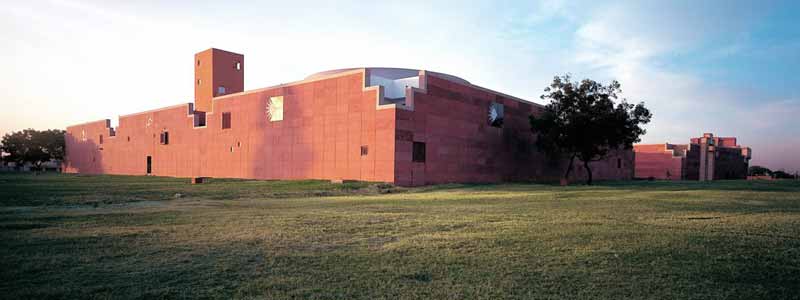
Best Time To Visit
The best time to visit Jawahar Kala Kendra is from September to December. This is the autumn season in Jaipur, and the city is magnificent in appearance. The heat of the sun is soft on the skin, thus making the afternoons ideal for sightseeing.
However, the temperatures may go as low as 4 degrees Celsius with cool evenings, so it is advisable to carry warm clothes.
Summer in Jaipur begins in May and ends in July. The climate during summers are extremely hot and dry, thus making the scorching heat of the sun unbearable.
The interiors of the Jaipur Kala Kendra may provide relief for a while, but the outside environment is constantly hot. Monsoon often comes bearing heavy and unpredictable rainfall between July and September.
How To Reach
Jawahar Kala Kendra is situated in Jhalana, Doongri which is about 8 km from Jaipur. This distance can easily be covered using a hired cab or taxi. However, they may be comparatively more expensive, yet the most convenient options. Another popular form of commutation is via auto-rickshaws. Do not forget to haggle as they are likely to charge you twice the actual amount.

